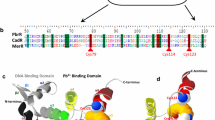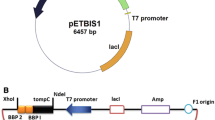Abstract
A highly specific lead-binding peptide ThrAsnThrLeuSerAsnAsn was displayed on Escherichia coli, and lead adsorption characteristics of the recombinant bacteria were investigated. Cell surface-displayed peptide was expressed under the control of an arabinose promoter using outer membrane protein C (OmpCt) as an anchoring motif. The optimal induction period and arabinose concentration for the expression of peptide-fused OmpCt were determined to be 2 h and 0.001 g/L, respectively. Selective adsorption of Pb2+ onto recombinant cells was verified with individual or combinatory use of four metal ions, Pb2+, Ni2+, Co2+, and Cu2+; the amount of bound Pb2+ onto the biosorbents was significantly higher than the other metal ions. The adsorption isotherm of recombinant cells for Pb2+ followed the Langmuir isotherm with a maximum adsorption loading (q max) of 526 μmol/g dry cell weight.







Similar content being viewed by others
References
Andrea, C. G. (2007). Endocrine-disrupting chemicals: from basic research to clinical practice (pp. 111–134). Totowa: Humana Press.
Maruyama, T., Hannah, S. A., & Cohen, J. M. (1975). Journal Water Pollution Control Federation, 47, 962–975.
Bayoumy, M. A. E., Bewtra, J. K., Ali, H. I., & Biswas, N. (1997). Canadian Journal of Civil Engineering, 24, 840–843.
Akram, A. A., & AL, H. (2007). Australian Journal of Basic and Applied Sciences, 1, 467–472.
Mejare, M., Ljung, S., & Bulow, L. (1998). Protein Engineering, Design & Selection, 11, 489–494.
Kotrba, P., Doleckova, L., de Lorenzo, V., & Ruml, T. (1999). Applied and Environmental Microbiology, 65, 1092–1098.
Saffar, B., Yakhchali, B., & Arbabi, M. (2007). Current Microbiology, 55, 273–277.
Ravikumar, S., Yoo, I. K., Lee, S. Y., & Hong, S. H. (2011). Applied Biochemistry and Biotechnology, 165, 1674–1681.
Nian, R., Kim, D. S., Nguyen, T., Tan, L., Kim, C. W., Yoo, I. K., & Choe, W. S. (2010). Journal of Chromatography. A, 1217, 5940–5949.
Blattner, F. R., Plunkett, G., Bloch, C. A., Perna, N. T., Burland, V., Riley, M., Collado-Vides, J., Glasner, J. D., Rode, C. K., Mayhew, G. F., Gregor, J., Davis, N. W., Kirkpatrick, H. A., Goeden, M. A., Rose, D. J., Mau, B., & Shao, Y. (1997). Science, 277, 1453–1462.
Xu, Z., & Lee, S. Y. (1999). Applied and Environmental Microbiology, 65, 5142–5147.
Jeanteur, D., Lakey, J. H., & Pattus, F. (1991). Molecular Microbiology, 5, 2153–2164.
Ravikumar, S., Yoo, I. K., Lee, S. Y., & Hong, S. H. (2011). Bioprocess and Biosystems Engineering, 34, 1119–1126.
Holan, Z. R., & Volesky, B. (1994). Biotechnology and Bioengineering, 43, 819–825.
Lo, W., Chua, H., Lam, K. H., & Bi, S. P. (1999). Chemosphere, 39, 2723–2736.
Park, H. G., Kim, T. W., Chae, M. Y., & Yoo, I. K. (2007). Process Biochemistry, 42, 1371–1377.
Acknowledgments
This work was supported by a Korea Research Foundation grant funded by the Korean Government (KRF-2008-521-D00230).
Author information
Authors and Affiliations
Corresponding author
Rights and permissions
About this article
Cite this article
Nguyen, T.T.L., Lee, H.R., Hong, S.H. et al. Selective Lead Adsorption by Recombinant Escherichia coli Displaying a Lead-Binding Peptide. Appl Biochem Biotechnol 169, 1188–1196 (2013). https://doi.org/10.1007/s12010-012-0073-2
Received:
Accepted:
Published:
Issue Date:
DOI: https://doi.org/10.1007/s12010-012-0073-2




